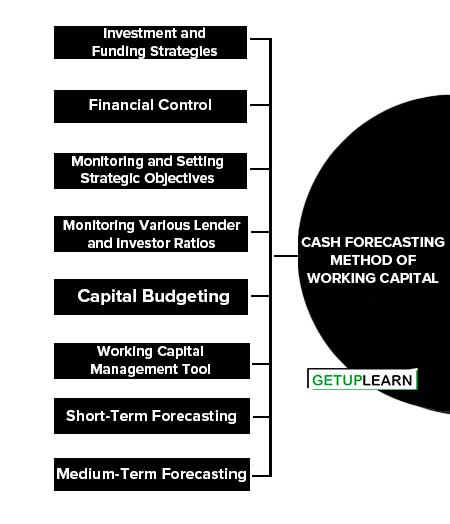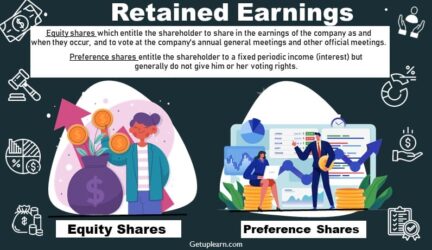Table of Contents
What is Cash Forecasting Method?
Cash forecasting can be a valuable aid to the cash manager if it is prepared well and used properly. Where it is prepared badly, it can be a significant waste of time for all involved. In companies that make good use of cash forecasting.
It may be used as an aid for some, or all, of the following:
- To set borrowing limits and minimize the cost of funds
- To maximize interest earnings
- For liquidity management
- For foreign exchange risk management
- For setting and monitoring longer-term investment and funding strategies
- For financial control
- To monitor and set strategic objectives
- For monitoring various lender and investor ratios
- For budgeting for capital expenditure and project appraisal
- As a tool for working capital management.
Total cash receipts and cash disbursements for a particular period are taken into consideration under the cash forecasting method. Cash receipts may be estimated cash sales, cash collected from debtors, bills receivables, other miscellaneous cash receipts, and the sale of fixed assets and investments. Delay in cash receipts is taken into consideration.
Cash Forecasting Method of Working Capital
Cash disbursements may be related to estimated cash purchases, payment to sundry creditors, repayment of loan, payment over bills payable, payment of wages, salaries, bonuses, and advances, payable to suppliers, repayment of loans and advances interest and principal amount, and the like.
The minimum cash balance designed to be maintained is added with the required disbursements and provision is also made for additional borrowings and the like. Both cash receipts and cash disbursements are recorded in a format.
These are the cash forecasting method of working capital:
- Investment and Funding Strategies
- Financial Control
- Monitoring and Setting Strategic Objectives
- Monitoring Various Lender and Investor Ratios
- Capital Budgeting
- Working Capital Management Tool
- Short-Term Forecasting
- Medium-Term Forecasting

Investment and Funding Strategies
Setting and Monitoring Longer-term Investment and Funding Strategies: In this case, cash forecasting techniques can be used as modeling tools. These should be able to identify future structural cash shortages and surpluses. Generally, this will be for periods in excess of one year.
Financial Control
Cash forecasting can often be used to model payables and receivables against known sales and purchases. This type of forecasting identifies mismatches between credit periods granted to customers and the amount of credit actually taken (Days Sales Outstanding).
It can also enable comparison with credit taken from suppliers (Days Purchases Outstanding) and hence identify working capital financing requirements. Such forecasts may be reconciled against actuals to ensure that subsidiary companies are managing their cash flows in line with plans and corporate policy (see also below section on working capital management).
Monitoring and Setting Strategic Objectives
Various corporate strategies and objectives can be planned using cash forecasting and reviewed or monitored by comparing actual cash flows relating to specific products, projects, or business units, against those planned.
Monitoring Various Lender and Investor Ratios
Borrowers normally have to comply with covenants set by lenders, or the company itself may either impose ratios on it or use them to benchmark itself against peer groups. Cash forecasting would be one of the techniques used within the company to monitor and even plan certain types of ratios.
Capital Budgeting
This type of cash flow projection will often be carried out by companies to ascertain that they are generating sufficient cash, not only to finance normal operating needs but also to finance the acquisition of new capital goods (e.g. machinery).
It is also often requested by banks or finance companies to ensure that potential borrowers are generating sufficient cash to enable them to make loan and interest payments without jeopardizing the other activities of the business.
Working Capital Management Tool
Increasingly cash forecasting techniques are being linked to working capital management. In this respect concepts such as ‘just in time’ delivery of raw materials can be refined and linked with ‘just in time’ payments and cash management.
As raw materials are ordered, paid for, and consumed, and stocks of finished goods are warehoused or sold the cash forecasts can be continually refined so that they become both a detailed cash planning tool and a method for managing actual and predicted cash flows and account balances.
Short-Term Forecasting
Short-term cash forecasting will be used for periods from ‘end of business today’ forward to 30 days. The objective of short-term forecasting is to identify cash receipts and payments with reasonable accuracy to aid the day-to-day management of bank accounts.
It seeks to identify short-term funding requirements and short-term surpluses that can be used for investment and will aid the cash manager in his borrowing and investment decisions. Short-term forecasting should be the main tool used to ensure that there are no idle balances sitting on noninterest or low-interest-bearing accounts.
Medium-Term Forecasting
Medium-term forecasting is used to estimate net cash positions for periods from one month to one year. This seeks to establish overall averages, rather than detailed daily positions and gives the treasurer a feel for the overall funding/investment patterns expected over the year.
Typically, companies using medium-term forecasting have a rolling monthly forecast that might be projected 12 months forward. In some volatile industries, where going as far forward as 12 months makes no sense, companies may only project forward three months.
The forecasts should be regularly updated on a monthly or quarterly basis as figures become more solid and as events change (e.g. sales forecasts being exceeded or not being met).
FAQs Section
What are the cash forecasting methods of working capital?
1. Investment and Funding Strategies
2. Financial Control
3. Monitoring and Setting Strategic Objectives
4. Monitoring Various Lender and Investor Ratios
5. Capital Budgeting
6. Working Capital Management Tool
7. Short-Term Forecasting
8. Medium-Term Forecasting.



